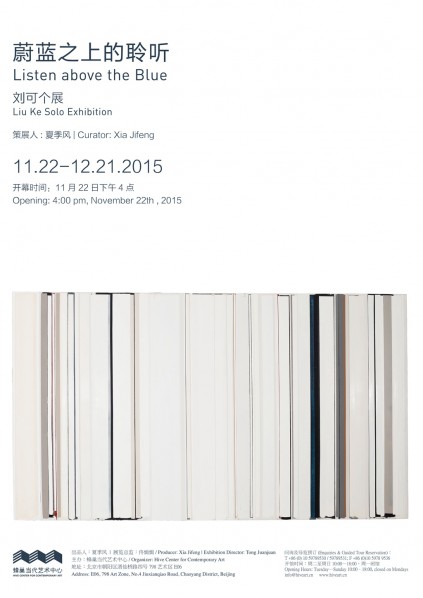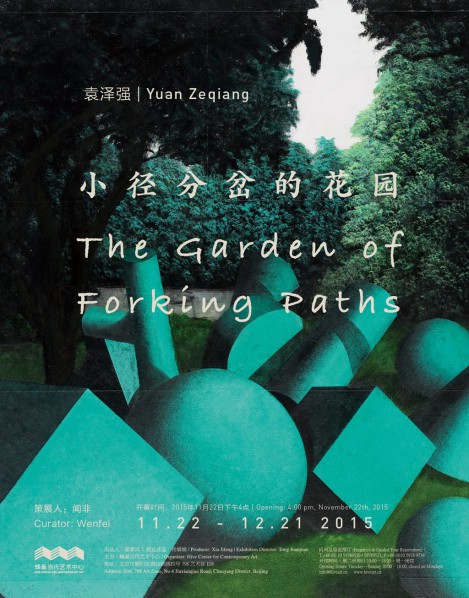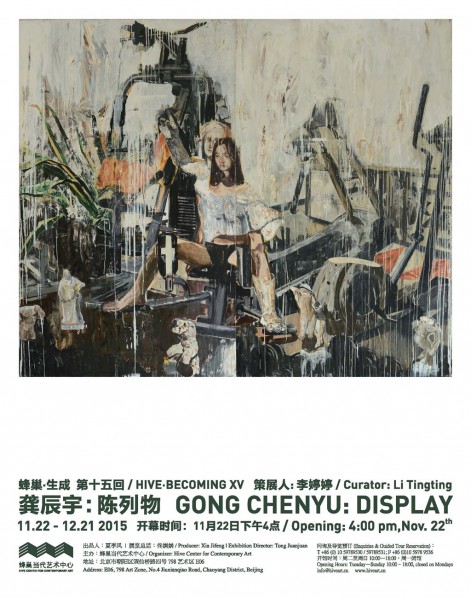
Hive Center for Contemporary Art is pleased to announce the opening of Listen above the Blue: Liu Ke Solo Exhibition on 22nd Nov at the Hall A. The exhibition will feature the works of the recent years by Liu Ke, including works on paper, canvas and installations. The exhibition is curated by Xia Jifeng and will last until 21st Dec.
The works created by Liu Ke from 2012 till now use color stripes to construct on the picture-plane, where the alternation of different colors, the vertical arrangement of color stripes and the interpenetrating, covering, overlaying between color stripes form a rhythmic and delicately-balanced space on the picture-plane. A blank canvas to Liu Ke is “a whole with limitation of only boundaries but no depths” , and the compositions of various color layers is a kind of “rivals”, The margins among the covering and overlapping of colors are the “measurement” of the blank layers, and the more they get squeezed, the bigger the “power” they are loaded. At the same time, the artist kept the paint’s sense of material existence on purpose, and the uneven depths resulted from overlapping and covering becomes an extension and proof of the “power” given out in the artist’s creation.
Viewers may have different impression about the “power” displayed in Liu Ke’s works, it may be rational and accurate, meanwhile in a intuitive and perceptual way. To make it by the metaphor of music, In structure his works feature the vertical arrangement like the pipes of the pipe organ, so they produce and deliver the sense of music exclusive to such a structure, and may bring audience the same pleasure as the pipe-organ-listening.
As a matter of fact, music or some kind of plausible melodies has been a recurrent element in almost all of Liu Ke’s previous paintings. This probably can be equivalent with what Kandinsky termed as “the musical mode behind images”. From Liu Ke’s early creations, such as Abstract 1 (1998), Deconstruction of Lust Series (2003), and Sound & Color Series (2006-2009), we can feel the existence of music at different levels. Unlike the music with emotions and a sense of order in his recent works, what fills the previous ones may be more disordered: mixed, irritable, ending abruptly; there’s even an unneeded tail attached to some notes. Liu Ke’s works, at some level, also reflect the influence a “post-70s” artist couldn’t reject and resist from the unscrupulous attitude of bantering that pervaded the air of the 1980s. Fortunately this was a short period, as his self-awareness in art soon kept him away from all the noise and clamor and re-established the constant boundary of order in creation.
As early as in 1911, Kandinsky wrote in his book Concerning The Spiritual In Art: “A painter, who finds no satisfaction in mere representation, however artistic, in his longing to express his inner life, cannot but envy the ease with which music, the most non-material of the arts today, achieves this end. He naturally seeks to apply the methods of music to his own art. And from this results that modern desire for rhythm in painting, for mathematical, abstract construction, for repeated notes of colour, for setting colour in motion.” Liu Ke has found in his abstract creation music and ease, a piece of "blue". Instead of a color, it’s a feeling, or the pleasure from the enjoyment of the spirit and the sensory organs. What we need to do in front of Liu Ke’s works is to purely watch and listen, opening all senses to drift on that piece of blue.
About the exhibition
Curator: Wenfei
Opening: 22nd Nov. 2015, 16:00
Exhibition Dates: 22nd Nov. - 21st Dec.2015

Yuan Zeqiang: The Garden of Forking Paths
Following the Hive·Becoming III Tropical Symptoms: Yuan Zeqiang's Solo Exhibition in 2013, Hive Center for Contemporary Art will feature the artist's new solo exhibition The Garden of Forking Paths on Nov. 22nd, 2015. The exhibition is curated by Wenfei and will be presented at Hall B.
In the Garden of Forking Paths, Jorge Luis Borges predicts a way of temporal perception: it is no longer homogeneous linear time, but takes on many complicated traits of space. Yuan Zeqiang shows a similar status in his paintings, in which he not only reflects the “fragmentality” of the contemporary perceptive mode, but also juxtaposes images of disparate times according to the logic of montage, like weaving an all-inclusive web of time in the “garden” of a surrealistic style.
In many of Yuan Zeqiang’s works, scenery in a tone of green dominates the picture, which resembles corners of a “garden”. Renaissance gardens rests on the modern rational planning of urban space, so regular geometric shapes and symmetric composition became the basic constructive pattern of the Renaissance gardens and parks. Although he adopts industrial grass powder to add a texture of “turf” to the scenes and constructs a seemingly organized visual appearance, Yuan parodies the Renaissance-style gardens by switching the structural relationship among things so as to subvert the stability of its spatial structure.
In effect, “collage” is an accustomed technique in Yuan Zeqiang’s creation, and he would even “re-create” directly on a photo. The emergence of photography has, as a matter of fact, advanced the application of “collage” in modern artistic creation. A photo is the taker’s “capture” of the real world and by nature a “collage” of time and space. Unlike painting, a photo should rather regarded as a “trace” of something: when a thing fades fatefully away with the passing of time, its two-dimensional copies would be reduced to a kind of “decontextualized” signifiers. As Susan Sontag put it, photography is inherently surrealistic – perhaps just because photography resets space and time in reality by means of “collage”.
In addition, Yuan Zeqiang’s embraces numerous images in a “critical state”, such as passages, entrances and exits, windows and doors. Not only does Yuan show the synchronicity in the existence of things through these images of space, but he also attempts to respond to the classical topics in art history. For instance, in the serious of Fixed Point and Culmination, Yuan suspends the concrete physical images and refers to a certain way of observation and reflection in terms of the principle of perspective in a more abstract manner. And in other works with tunnels or passages as basic spatial structures, Yuan still employs the perspective composition, but, through techniques like collage and transplantation, produces visual effects that violate the spatial logic of perspective, so as to probe into the significance of perspective in a contemporary context with the multi-viewpoint and dynamic approach of montage.
About the exhibition
Curator: Wenfei
Opening: 22nd Nov. 2015, 16:00
Exhibition Dates: 22nd Nov. - 21st Dec.2015

Hive Center for Contemporary Art is honored to announce the opening of Hive·Becoming XV Gong Chenyu: Display on 22nd Nov. Born in Qiqihar in 1988, Gong Chenyu graduated 2015 from China Academy of Art with Marster's Degree from the Oil Painting Department, previously with Bachelor's Degree from Sculpture Department. The Exhibition will present his works from the former "Sleepless" and "the Five Sences" Series to the recent "Display" Series at the halls C/D/E. The exhibition is curated by Li Tingting and will last until 21st Dec.2015.
Courtesy of the artists and Hive Center for Contemporary Art, for further information please visit www.hiveart.cn.




























